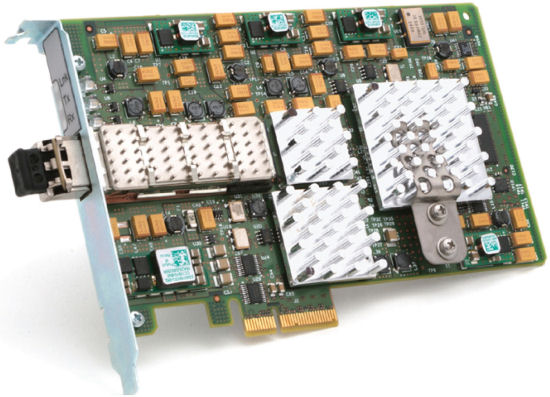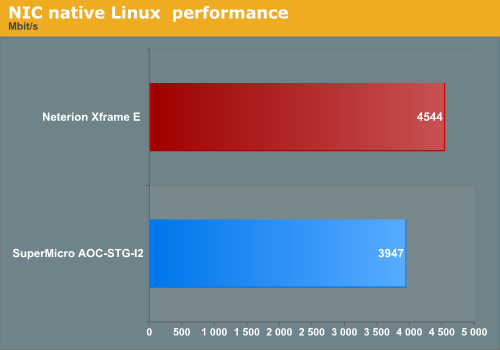10Gbit Ethernet: Killing Another Bottleneck?
by Johan De Gelas on March 8, 2010 12:00 PM EST- Posted in
- IT Computing
The Hardware
As always, we worked with the hardware we have available in the labs.

The Neterion Xframe-E is neither Neterion’s latest nor greatest. It came out in 2008 and was one of the first PCI Express NICs that supported VMware’s NetQueue feature in ESX 3.5, so we felt this pioneer in network virtualization should be included. The latest Neterion NICs are the X3100 series, but those cards were not available to us. The Xframe-E has eight transmit and eight receives queues available, TCP checksum offload, and TCP segment send/receive offload. The card uses a PCIe 1.1 x8 connector. Typical power consumption is around 12W. More info here. Our Neterion Xframe-E used optical SR multi-mode fiber, but a CX4 version is also available.

The Supermicro AOC-STG-I2 was also first made available in 2008, but we got the version that was sold in 2009. It is based on the Intel 82598EB chip. It supports checksum offloading and even iSCSI booting. 16 virtual queues are available. Power consumption should not be higher than 6.5W. More info here.
Native performance
We first tested on the Linux distribution CentOS 5.4, based on the 2.6.18 kernel. The first goal was to understand whether 10Gbit cards make sense for non-virtualized platforms.

The Neterion needed 6% of our 8 2.9GHz Opteron cores, the Intel chip on our Supermicro card only 2.5%. Despite these low percentages, both cards cannot reach half their potential. These rather expensive cards do not seem to be very attractive next to a simple quad-port 1Gbit/s Ethernet card.










49 Comments
View All Comments
radimf - Wednesday, March 10, 2010 - link
HI,thanks for article!
Btw I am reading your site because of your virtualization articles.
I planned almost 3 years ago for IT project with only a 1/5 of complete budget for small virtualization scenario.
If you want redundancy, It can´t get much simplier than that:
- 2 ESX servers
- one SAN + one NFS/iSCSI/potentially FC storage for D2D backup
- 2 TCP switches, 2 FC switches
world moved, IT changed, EU dotation took too long to process - we finished last summer what was planned years ago...
My 2 cents from small company finishing small IT virtualization project?
FC saved my ass.
iSCSI was on my list (DELL gear), but went FC instead(HP) for lower total price (thanks crisis :-)
HP hardware looked sweet on specs sheets, and actual HW is superb, BUT.... FW sucked BIG TIME.
IT took HP half year to fix it.
HP 2910al switches do have option for up to 4 10gbit ports - that was the reason I bought them last summer.
Coupled with DA cables - very cheap solution how to get 10gbit to your small VMware cluster. (viable 100% now)
But unfortunatelly FW (that time) sucked so much, that 3 out of 4 supplied DA cables did not work at all (out of the box).
Thanks to HP - they changed our DA for 10gbit SFP+ SR optics! :-)
After installation we had several issues with "dead ESX cluster".
Not even ping worked!
FC worked flawlessly through these nightmares.
Swithces again...
Spanning tree protocol bug ate our cluster.
Now we are happy finally. Everything works as advertised.
10gbit primary links are backed up by 1gbit stand-by.
Insane backup speeds of whole VMs compared to our legacy SMB solution to nexenta storage appliance.
JohanAnandtech - Monday, March 8, 2010 - link
Thank you. Very nice suggestion especially since we already started to test this out :-). Will have to wait until April though, as we got a lot of server CPU launches this month;Lord 666 - Monday, March 8, 2010 - link
Aren't the new 32nm Intel server platforms coming with standard 10gbe nics? After my SAN project, going to phase in the new 32nm cpu servers mainly for AES-NI. The 10gbe nics would be an added bonus.hescominsoon - Monday, March 8, 2010 - link
It's called xsigo(pronounced zee-go) and solves the i/o issue you are tying to solve here for vm i/o bandwidth.JohanAnandtech - Monday, March 8, 2010 - link
Basically, it seems like using infiniband to connect each server to an infinibandswitch. And that infiniband connection is then used by a software which offers both a virtual HBA and a virtual NIC. Right? Innovative, but starting at $100k, looks expensive to me.vmdude - Monday, March 8, 2010 - link
"Typically, we’ll probably see something like 20 to 50 VMs on such machines."That would be a low vm per core count in my environment. I typically have 40 vms or more running on a 16 core host that is populated with 96 GB of Ram.
ktwebb - Sunday, March 21, 2010 - link
Agreed. With Nahalems it's about a 2 VM's per core ratio in our environment. And that's conservative. At least with vSphere and overcommit capabilities.duploxxx - Monday, March 8, 2010 - link
All depends on design and application type, we typically have 5-6 VM's on a 12 core 32GB machine and about 350 of those, running in a constant 60-70% CPU utilization range.switcher - Thursday, July 29, 2010 - link
Great article and comments.Sorry I'm so late to this thread, but I was curious to know what the vSwitch is doing during the benchmark? How is it configured? @emuslin notes that SR-IOV is more than just VMDq, and AFAIK the Intel 82598EB doesn't support SR-IOV so what we're seeing it the boost from NetQueue. What support for SR-IOV is there in ESX these days?
I'd be nice to see SR-IOV data too.